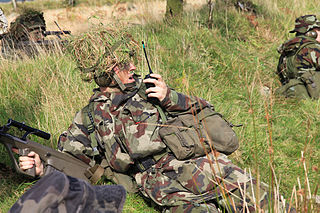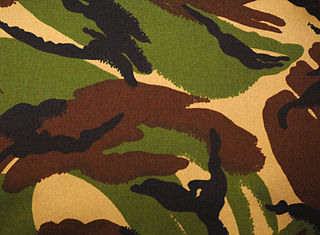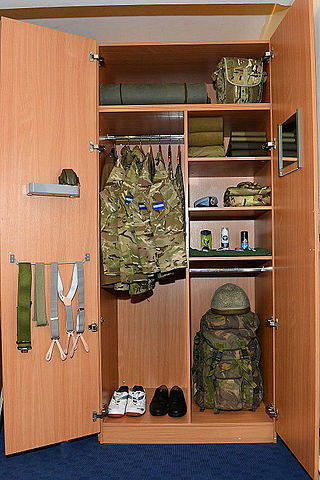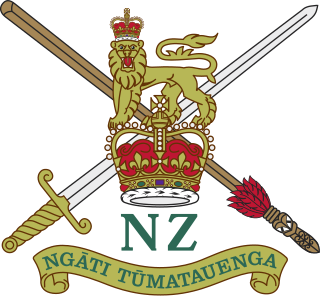
Flecktarn is a family of three-, four-, five- or six-color disruptive camouflage patterns, the most common being the five-color pattern, consisting of dark green, grey-green, red brown, and black over a light green or tan base depending on the manufacturer. The original German five-color pattern was designed for use in European temperate woodland terrain. A three-color variation called Tropentarn is intended for arid and desert conditions; the German Bundeswehr wore it in Afghanistan.

The Army Combat Uniform (ACU) is the current combat uniform worn by the United States Army, U.S. Air Force, and U.S. Space Force. Within U.S. Air Force and U.S. Space Force, it is referred to as the OCP Uniform, rather than the Army Combat Uniform.

A combat uniform, also called field uniform, battledress or military fatigues, is a casual type of uniform used by military, police, fire and other public uniformed services for everyday fieldwork and combat duty purposes, as opposed to dress uniforms worn in functions and parades. It generally consists of a jacket, trousers and shirt or T-shirt, all cut to be looser and more comfortable than more formal uniforms. Design may depend on regiment or service branch, e.g. army, navy, air force, marines, etc. In the army branches, fabrics tend to come in camouflage, disruptive pattern or else green, brown or khaki monochrome, in order to approximate the background and make the soldier less visible in nature. In Western dress codes, field uniform is considered equivalent to civilian casual wear. As such, field uniform is considered less formal than service dress uniform, generally aimed at office or staff use, as well as mess dress uniform, and full dress uniform.

Personal Load Carrying Equipment (PLCE) is one of several tactical webbing systems of the British Armed Forces. Dependent upon the year of design, and the decade of introduction, the webbing system was named and is commonly referred to as the 85 Pattern, the 90 Pattern or the 95 Pattern webbing.

Disruptive Pattern Material (DPM) is the commonly used name of a camouflage pattern used by the British Armed Forces as well as many other armed forces worldwide, particularly in former British colonies.

The Denison smock was a coverall jacket issued to Special Operations Executive (SOE) agents, the Parachute Regiment, the Glider Pilot Regiment, Air Landing Regiments, air observation post squadrons, Commando units, and other Commonwealth airborne units, to wear over their Battle Dress uniform during the Second World War. The garment was also issued as standard to the scout and sniper platoons of line infantry battalions.

MultiCam is a camouflage pattern designed for use in a wide range of environments and conditions which was specifically developed and is produced by American company Crye Precision. As a result of the pattern's effectiveness across disparate environments and regions, it has found extensive adoption globally. Variants of it, some unlicensed, are in use with armed forces worldwide, particularly with special operations units.

The uniforms of the British Army currently exist in twelve categories ranging from ceremonial uniforms to combat dress. Uniforms in the British Army are specific to the regiment to which a soldier belongs. Full dress presents the most differentiation between units, and there are fewer regimental distinctions between ceremonial dress, service dress, barrack dress and combat dress, though a level of regimental distinction runs throughout.

The Desert Camouflage Uniform (DCU) is an arid-environment camouflage uniform that was used by the United States Armed Forces from the mid-1990s to the early 2010s. In terms of pattern and textile cut, it is identical to the U.S. military's Battle Dress Uniform (BDU) uniform, but features a three-color desert camouflage pattern of dark brown, pale olive green, and beige, as opposed to the four-color woodland pattern of the BDU. It replaced the previous Desert Battle Dress Uniform (DBDU) which featured a six-color "chocolate chip" pattern of beige, pale olive green, two tones of brown, and black and white rock spots. Although completely phased out of frontline use in the U.S. Armed Forces, some pieces and equipment printed in the DCU camouflage pattern are used in limited numbers such as MOPP suits and/or vests.

The New Zealand disruptive pattern material, also known as New Zealand DPM (NZDPM), was the official camouflage pattern on uniforms of the New Zealand Defence Force from 1980 until 2013. It was replaced with a new pattern called Multi Terrain Camouflage (MCU) which was exclusive to the NZDF. This was in turn replaced by the New Zealand Multi Terrain Pattern (NZMTP) from 2020.

The Afghanka is a type of military uniform system developed and issued by the Soviet Army in the early 1980s, still in use today in some Post-Soviet states in many different variants. The name Afghanka is an unofficial popular slang term in Russian for the uniform, derived from its prolific use during the Soviet–Afghan War. All the non-sand coloured versions of the M88 are not called Afghanka.

Splittertarnmuster, Splittertarn or Splittermuster (splinter-pattern) is a four-colour military camouflage pattern developed by Germany in the late 1920s, first issued to the Reichswehr in 1931.

The Multi-Terrain Pattern (MTP) is the standard camouflage pattern of the British Armed Forces.

Canadian Disruptive Pattern is the computer-generated digital camouflage pattern developed for use by the Canadian Armed Forces. Four operational variations of CADPAT have been used by the Canadian Armed Forces: a temperate woodland pattern, an arid regions pattern, a winter operations pattern, and a multi-terrain pattern.

The New Zealand Army uniform has changed over the years from that of the original Armed Constabulary of the 1800s to the modern Army Combat Uniform style in use by the majority of world armies today. While British Army influence has always been strong, distinctive New Zealand features have gradually developed. From 2013 the New Zealand Army uniform underwent a complete redesign with a new and distinctive camouflage pattern unique to the NZDF.

General Purpose Uniform (GPU) is the working uniform of the Royal Australian Air Force.

Operational Camouflage Pattern (OCP), originally codenamed Scorpion W2, is a military camouflage pattern adopted in 2015 by the United States Army for use as the U.S. Army's main camouflage pattern on the Army Combat Uniform (ACU). This pattern officially replaced the U.S. Army's previous Universal Camouflage Pattern (UCP) as the official combat uniform pattern for most U.S. soldiers at the end of September 2019. The pattern also superseded the closely related MultiCam, a pattern previously used for troops deploying to Afghanistan.

The Australian Multicam Camouflage Uniform (AMCU) is the combat uniform camouflage pattern for the Australian Defence Force, general issued from 2014 onwards. The AMCU is replacing the previously used Disruptive Pattern Camouflage Uniform (DPCU) and Australian Multicam Pattern - Operational Combat Uniform (AMP-OCU) camouflage patterns.
The uniforms of the Australian Army have changed significantly over the past century, although the accoutrements worn over this period have remained relatively similar. The forces of the Australian colonies and the early forces of the Commonwealth post-Federation in 1901 closely followed the uniforms of the British Army. Since then it has continued to be influenced by British but also US styles, as well as including some distinctly Australian designs, reflecting local conditions and trends.

EMR ; or Universal Camouflage Colourway in English, is a military camouflage pattern in use by the Russian Armed Forces. It is sometimes referred to by the unofficial nicknames RUSPAT, Tetris, Tsifra and Digital Flora. EMR camouflage is the standard camouflage pattern of the Russian Military's VKBO All-Season Uniform.

























